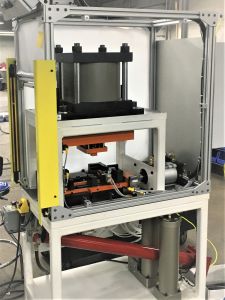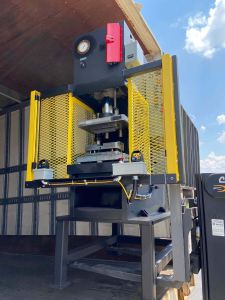Custom Assembly Presses
What is a Custom Assembly Press? How can I determine what kind of Assembly Press I need to use in my assembly application?
[Pictures of Stryver built or restored Assembly Presses below]
When you think of a press, likely the first thing that comes to mind is a large stamping press. These presses are off-the-shelf and require custom machined dies to work to stamp your part. But in many cases, a stamping press is not what is needed to get the job done. Some parts are not as simple or as straightforward to press as stampings. Items like steering columns, window frames, or axles need more creative press solutions to get the job done right. A custom assembly press is generally the best solution to produce certain parts because it can be designed and built in the most efficient way possible to handle these parts. In turn, using a custom press minimizes not only the additional cost of buying an oversized off-the-shelf press, it also reduces the amount of manipulation required by the operator to handle the pressing operation.
Below is a summary of common custom assembly presses types, with advantages & applications for each type:
- Servo Press. Uses a programmable servo motor to drive the custom assembly press ram to a precise position. Can apply high, medium or low amounts of force. Best used in applications where high loading precision is required, or a large part mix is required to be ran on a single press.
- Air (Pneumatic) Press. Uses a pneumatic actuator to drive the custom assembly press ram to a position. Often uses tooling to create set points. Can apply medium to low amounts of force. Best used in applications where lower press loading is required, loading precision is not important, and a small part mix only is needed for lower build cost.
- Air/Hydro (Air Over Oil) Press. Uses a contained hydraulic system to further control a pneumatic assembly pressing system. Used to obtain precision loading in medium to low loading applications that air pressing alone cannot achieve.
- Hydraulic Press. Uses a contained hydraulic system only to complete a pressing operation. Great for high and medium loading applications. Best used in applications where high precision loading is needed and oil/grease are OK in the production environment.
- Manual Press. Uses a manual actuator to allow an operator to drive a press ram to position for loading. Can apply low amounts of force. Used in applications where controlled alignment of a manual assembly pressing process is needed.
At Stryver, we have designed and built custom assembly presses that do everything from pushing bushings into stampings to pressing garage door window assemblies. We can size the press, design and build the tooling required to support the press, and handle the safety integration to ensure you have a turnkey press that is ready for parts






































